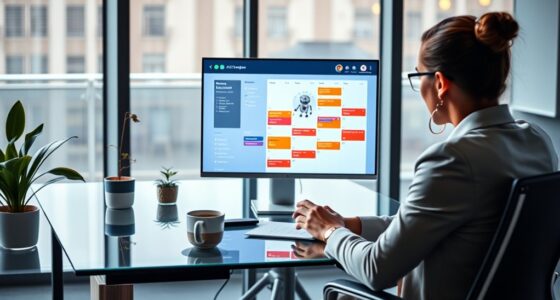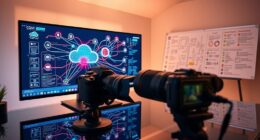To improve your focus through digital minimalism, start by recognizing digital distractions like notifications and endless scrolling. Set clear boundaries by tracking your screen time and designating specific times for social media use. Make your digital habits intentional by turning off alerts and unfollowing unhelpful accounts. Establish tech-free zones and moments to reset mentally. Embracing these strategies helps you enjoy deeper concentration and balance—discover more ways to make your digital life work for you.
Key Takeaways
- Set specific times for social media use to minimize distraction and maintain focus.
- Turn off non-essential notifications to reduce digital interruptions.
- Create tech-free zones and periods to foster deeper concentration and mental clarity.
- Unfollow or mute accounts that cause anxiety or waste time, making your digital space more intentional.
- Track and limit overall screen time to reclaim attention and enhance productivity.

Have you ever felt overwhelmed by the constant barrage of notifications, apps, and digital distractions? It’s easy to get caught up in the endless scroll of social media and the never-ending pull of your screen time. Every ping or alert seems designed to grab your attention, pulling you away from what truly matters. But if you want to regain control and improve your focus, embracing digital minimalism can help. Reducing your screen time and limiting social media use isn’t about cutting out technology altogether; it’s about making intentional choices that serve your goals and well-being.
Start by evaluating how much time you spend on your devices. Track your screen time for a few days and identify which apps or platforms consume most of your attention. You might discover that social media accounts take up more of your day than you realized, often leading to wasted hours and mental clutter. Once you recognize these patterns, set boundaries. For example, designate specific times for checking social media—perhaps before breakfast or after work—and avoid mindless scrolling outside those windows. This creates space for deeper focus and reduces the mental fatigue that comes with constant switching between tasks.
Limiting social media doesn’t mean quitting cold turkey; it’s about making your digital environment more intentional. Unfollow or mute accounts that don’t add value or make you feel anxious. Turn off notifications to prevent your device from constantly pulling you back into the digital world. Instead of letting social media dictate your mood or schedule, decide when and how you engage. Use apps or settings to restrict access during certain hours, giving yourself a digital detox when needed. The goal is to reclaim your attention and foster concentration on activities that truly matter, whether it’s work, hobbies, or quality time with loved ones.
Creating a dedicated tech-free zone or time period can also boost your focus. For example, establish a no-screen rule during meals or an hour before bed. These small changes offer big benefits, helping your brain reset and recharge without constant interruptions. Additionally, focusing on mindful decluttering of digital spaces—such as clearing out unused apps or organizing files—can further reduce mental clutter and enhance clarity. Remember, digital minimalism isn’t about deprivation; it’s about making space for meaningful experiences and reducing the noise that hampers your concentration. By consciously managing your screen time and social media habits, you empower yourself to focus more deeply, work more efficiently, and enjoy your time offline. Over time, these intentional adjustments become habits that support a more balanced, focused, and fulfilling life.
Frequently Asked Questions
How Does Digital Minimalism Improve Mental Health?
Digital minimalism improves your mental health by reducing screen fatigue and helping you regain emotional resilience. When you limit unnecessary digital distractions, you spend less time overwhelmed and more time connecting with yourself and others. This clarity boosts your mood, decreases anxiety, and strengthens your ability to handle stress. As a result, you feel more balanced, focused, and emotionally resilient, creating a healthier mental state over time.
Can Digital Minimalism Help With Productivity?
Studies show that tech addiction can decrease productivity by up to 40%. Digital minimalism helps you cut through distractions, making it easier to focus on what truly matters. By doing a social media detox and limiting unnecessary notifications, you free up mental space and energy. This intentional approach boosts your efficiency, helping you accomplish more in less time, and ultimately, enhances your overall productivity.
What Tools Assist in Maintaining Digital Minimalism?
You can stay on track with digital minimalism by using app blockers to limit your access to distracting apps and websites. Notification management tools help you control when and how you receive alerts, reducing interruptions. These tools enable you to focus more deeply and maintain your digital boundaries, ensuring you spend less time on unnecessary digital clutter and more on what truly matters.
Is Digital Minimalism Suitable for Children and Teens?
Yes, digital minimalism can be suitable for children and teens. It helps you manage screen time effectively and encourages healthier digital habits. Using parental controls allows you to set limits and monitor their device usage, ensuring they don’t get overwhelmed or distracted. By guiding them toward intentional device use, you foster focus and balance, making digital minimalism a valuable approach for young users.
How Long Does It Take to See Benefits From Digital Minimalism?
Think of it like waiting for a dial-up internet connection to load; the benefits of digital minimalism show up within a few weeks. You can expect to see measurable outcomes—like improved focus and reduced screen time—after about 3 to 4 weeks. Your progress depends on consistency, but with intentional effort, you’ll start noticing positive changes in your mental clarity and productivity sooner than you think.
Conclusion
By embracing digital minimalism, you regain control over your focus and prioritize what truly matters. Cutting back on distractions allows you to work more intentionally and find peace amid the chaos. Remember, sometimes less is more—removing the noise clears the way for clarity and purpose. Stay committed to simplifying your digital life, and you’ll find that clear waters run deep. Ultimately, it’s about working smarter, not harder, so you can truly thrive.









